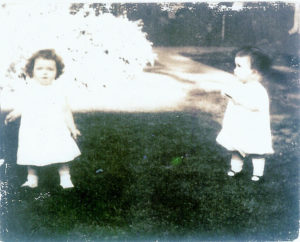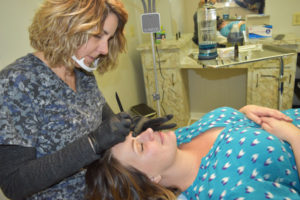James Rada, Jr.
Although it is referred to as the Gettysburg casino, a newly proposed plan to place a racetrack and casino in Freedom Township would actually be closer to Emmitsburg than Gettysburg.
David LeVan, who has tried unsuccessfully twice before to put a casino in Adams County, has proposed a horse racetrack and casino called Mason-Dixon Downs at 4200 Emmitsburg Road. LeVan is an Adams County businessman who owns Battlefield Harley-Davidson, northeast of Gettysburg.
Besides gaming, the facility would also offer Standardbred harness racing. LeVan told the Gettysburg Times that Mason-Dixon Downs would be along the Mason-Dixon Line, less than a mile from the Emmitsburg Road. It is a 700-acre parcel that is 2.5 miles from the Eisenhower Hotel and Conference Center and 3.2 miles from Gettysburg National Military Park. He also told the newspaper that it would create hundreds of jobs.
In a press conference announcing the project, he said, “We’ve listened to those who were concerned about our previously proposed location. That’s why this project is located 2.5 miles further southeast, across a major highway and along the Maryland border.”
This also places the casino and racetrack closer to Emmitsburg. Mason-Dixon Downs could open as early as 2019.
Emmitsburg Mayor Don Briggs says that the people in town with whom he has spoken feel that the casino and racetrack would be a good thing for Emmitsburg.
“It’s speculative right now,” Briggs said “but the business people are very receptive to it. They feel if it did come about, it would have a positive effect on their businesses.”
Briggs said that although a portion of the property extends into Maryland, he doesn’t know if any state or county officials have been contacted about it, but town officials haven’t been. He believes that the project, if it happens, would have some impact on the town.
“We have 215 acres on the east side of U.S. Route 15,” Briggs said. “It could stimulate development there. That would be a good thing.”
In 2006, LeVan proposed placing a casino near the Route 15 and Route 30 intersection near his motorcycle business. It was rejected by the Pennsylvania State Gaming Control Board, in part, because of its nearness to the Gettysburg Battlefield. In 2010, LeVan proposed a second location at the Eisenhower Hotel and Conference Center. It was further away from the battlefield but about ten miles closer to Emmitsburg. The proposal was also denied.
LeVan will be applying for a category 1 gaming license, which is sometimes called a racino license. It allows racetracks to have up to 250 table games and 5,000 slot machines. Pennsylvania law allows for seven of these licenses. Six have been awarded so far.
For LeVan’s proposal, it would be a two-step process. The license was intended for existing racetracks, but allowances were made for new facilities. Mason-Dixon Downs would have to have hosted at 150 days of live racing by the second year of the license approval. However, Pennsylvania is currently considering softening this requirement.
It is expected that the project would benefit Hanover Shoe Farms near Littlestown, which is known for its breeding harness-racing horses.
This project is still in its early stages, and officials are waiting to see more details. The project already ran into its first delay when the Freedom Township Board of Supervisors failed to move the proposal forward to the planning commission until more details are received.
Another hold up (this one known beforehand) was that the Pennsylvania Horse Racing Commission needed to work out the application process for a harness racing track.

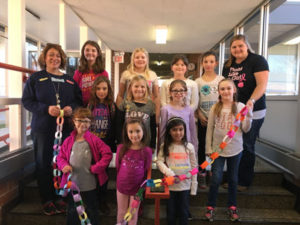
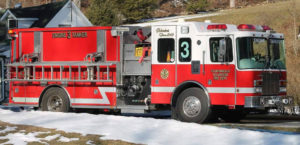 State and county lines are no barrier when it comes to fighting fires. The Fountaindale Volunteer Fire Department is located in Adams County, Pennsylvania, but when needed, they provide mutual aid to Frederick and Washington counties in Maryland, as well as Franklin County in Pennsylvania.
State and county lines are no barrier when it comes to fighting fires. The Fountaindale Volunteer Fire Department is located in Adams County, Pennsylvania, but when needed, they provide mutual aid to Frederick and Washington counties in Maryland, as well as Franklin County in Pennsylvania.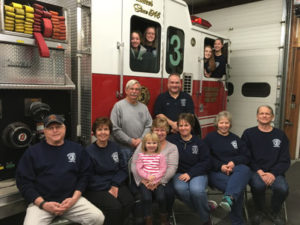
 Dear Reader: This is a column to help you determine the history and value of your heirlooms, attic finds, flea market purchases, or antique items. Please send a picture and description of your piece, such as how you acquired it and any details about its history, to tomandlisa@wildblue.net. I’ll research any item, whether it’s a piece of furniture, a painting, a tool, a doll, a figurine, or an article of clothing. An approximate value will be determined to inform you if it’s a “Trinket or Treasure.” Please submit all pictures and questions by the preceding 15th of the month for possible publication in the next monthly issue of The Catoctin Banner. All inquiries will be answered; however, only those selected for publication will include approximate value assessments. Furthermore, not all submissions may be published in the Banner due to space considerations. Please include your name or initials and where you reside. Thank you and happy treasure hunting!
Dear Reader: This is a column to help you determine the history and value of your heirlooms, attic finds, flea market purchases, or antique items. Please send a picture and description of your piece, such as how you acquired it and any details about its history, to tomandlisa@wildblue.net. I’ll research any item, whether it’s a piece of furniture, a painting, a tool, a doll, a figurine, or an article of clothing. An approximate value will be determined to inform you if it’s a “Trinket or Treasure.” Please submit all pictures and questions by the preceding 15th of the month for possible publication in the next monthly issue of The Catoctin Banner. All inquiries will be answered; however, only those selected for publication will include approximate value assessments. Furthermore, not all submissions may be published in the Banner due to space considerations. Please include your name or initials and where you reside. Thank you and happy treasure hunting!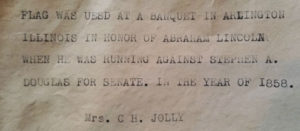
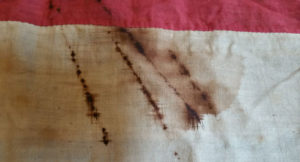 “Attached are some pictures of the 30-star, hand-stitched, pre-Civil war flag we found at my mother’s (she died recently). It originated from my Dad’s side, as the note we found with it was from my grandmother. How she got it, I do not know. We found it in a bag of linens, along with a flag of 48 stars (we almost didn’t look in there and were going to just put it with the other Goodwill items). It is approximately 10’ in length. It is hand-stitched and shows some wear. It has some tears along the upper edge and a “blood” or wine stain in the middle. The note says it was at a banquet in Arlington (Heights), Illinois, held in honor of Abraham Lincoln in 1858. Attached is a full picture of the flag, the note, and some of the stitching. We don’t really know what do with it, what its value is, if any, or who to contact to verify its story.”
“Attached are some pictures of the 30-star, hand-stitched, pre-Civil war flag we found at my mother’s (she died recently). It originated from my Dad’s side, as the note we found with it was from my grandmother. How she got it, I do not know. We found it in a bag of linens, along with a flag of 48 stars (we almost didn’t look in there and were going to just put it with the other Goodwill items). It is approximately 10’ in length. It is hand-stitched and shows some wear. It has some tears along the upper edge and a “blood” or wine stain in the middle. The note says it was at a banquet in Arlington (Heights), Illinois, held in honor of Abraham Lincoln in 1858. Attached is a full picture of the flag, the note, and some of the stitching. We don’t really know what do with it, what its value is, if any, or who to contact to verify its story.”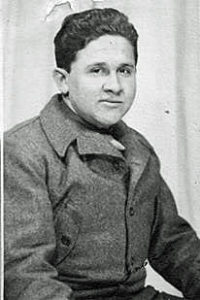
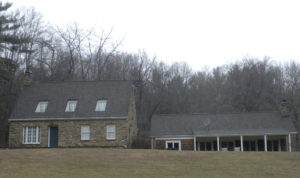
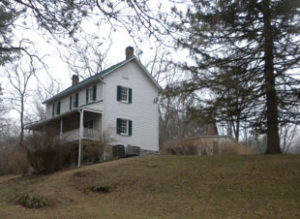
 The members of the Thurmont Community Ambulance Service, Inc. have officially opened a large facility for public event rentals and their own fundraising activities. This 28,600-square-foot venue was designed by Company member, Jim Rice. It is situated on 21.5 acres of ground, adjacent to the Thurmont Little League baseball fields in Thurmont, and accessed by Lawyer’s Lane off of Route #550.
The members of the Thurmont Community Ambulance Service, Inc. have officially opened a large facility for public event rentals and their own fundraising activities. This 28,600-square-foot venue was designed by Company member, Jim Rice. It is situated on 21.5 acres of ground, adjacent to the Thurmont Little League baseball fields in Thurmont, and accessed by Lawyer’s Lane off of Route #550.

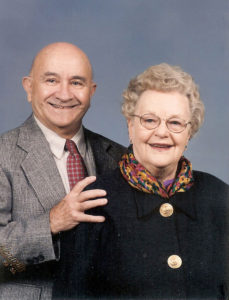 Earl A. Rice, Jr. and Mary (Gene) Eugenia (Matthews) Rice were meant to be together. Some of the family members joke that their marriage was an arranged one. Earl and Gene first met in the backyard of the old Rouzer home in Thurmont, from which, the wall paper, now in the Diplomatic Reception Room of the White House, came. Their mothers—Jessie (Rouzer) Matthews and Helen (Creager) Rice—grew up as next-door neighbors, and were visiting their childhood homes with their first born on the same weekend, sometime in 1924—when someone snapped the above picture. It must have been love at first sight, because they grew up separated by a mountain range and thirty-five miles. They would see each other on occasion during these kinds of weekend visits and dated during their teens and early twenties. They mostly double-dated—the only way Jessie found acceptable—and have many fond memories of those times. Earl sometimes got to borrow his mother’s Lincoln Zephyr, so they got to date in style. Mostly, he came in the Model A that he and his lifelong friend, Henry Steiger, owned together.
Earl A. Rice, Jr. and Mary (Gene) Eugenia (Matthews) Rice were meant to be together. Some of the family members joke that their marriage was an arranged one. Earl and Gene first met in the backyard of the old Rouzer home in Thurmont, from which, the wall paper, now in the Diplomatic Reception Room of the White House, came. Their mothers—Jessie (Rouzer) Matthews and Helen (Creager) Rice—grew up as next-door neighbors, and were visiting their childhood homes with their first born on the same weekend, sometime in 1924—when someone snapped the above picture. It must have been love at first sight, because they grew up separated by a mountain range and thirty-five miles. They would see each other on occasion during these kinds of weekend visits and dated during their teens and early twenties. They mostly double-dated—the only way Jessie found acceptable—and have many fond memories of those times. Earl sometimes got to borrow his mother’s Lincoln Zephyr, so they got to date in style. Mostly, he came in the Model A that he and his lifelong friend, Henry Steiger, owned together.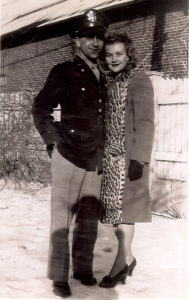 Earl and Gene lived for a time in California, then onto various assignments, including Pecos, Texas, where these East Coast kids had to contend with such things as spiders and West Texas dust storms. Earl and his crew had to travel separately on a troop train, while the wives followed with one of his fellow officer’s mother as a chaperone, another sign of a different time. Gene made some lifelong friends, with many of the wives demonstrating the love that has endeared her to all those around her. Only a short time after their marriage, Earl and his crew were assigned to their B-29 in the South Pacific Island of Tinian. They had to travel on a troop ship to meet up with their aircraft. Gene headed back home.
Earl and Gene lived for a time in California, then onto various assignments, including Pecos, Texas, where these East Coast kids had to contend with such things as spiders and West Texas dust storms. Earl and his crew had to travel separately on a troop train, while the wives followed with one of his fellow officer’s mother as a chaperone, another sign of a different time. Gene made some lifelong friends, with many of the wives demonstrating the love that has endeared her to all those around her. Only a short time after their marriage, Earl and his crew were assigned to their B-29 in the South Pacific Island of Tinian. They had to travel on a troop ship to meet up with their aircraft. Gene headed back home.